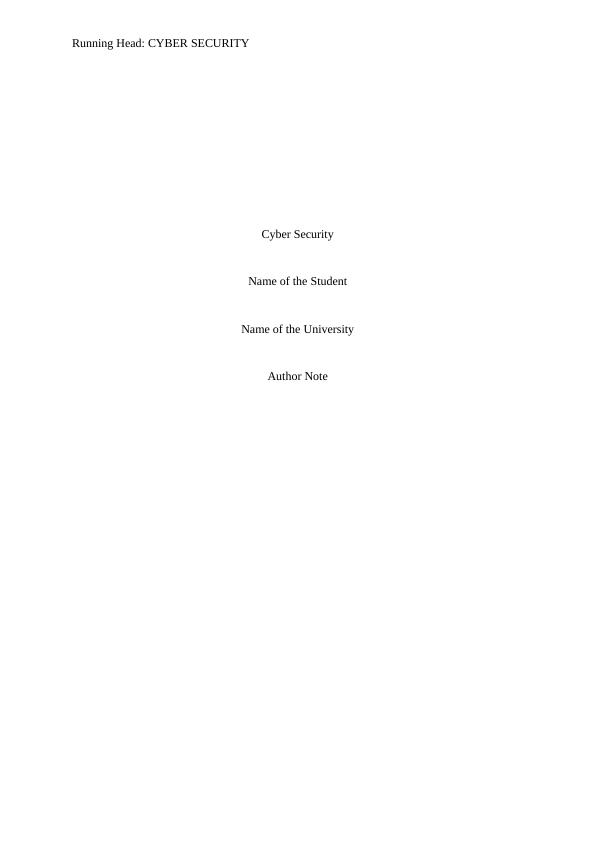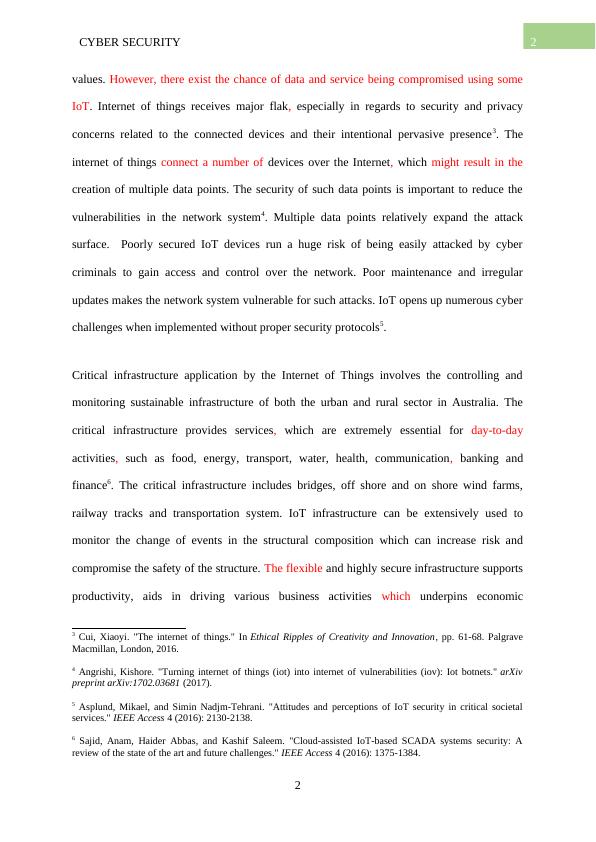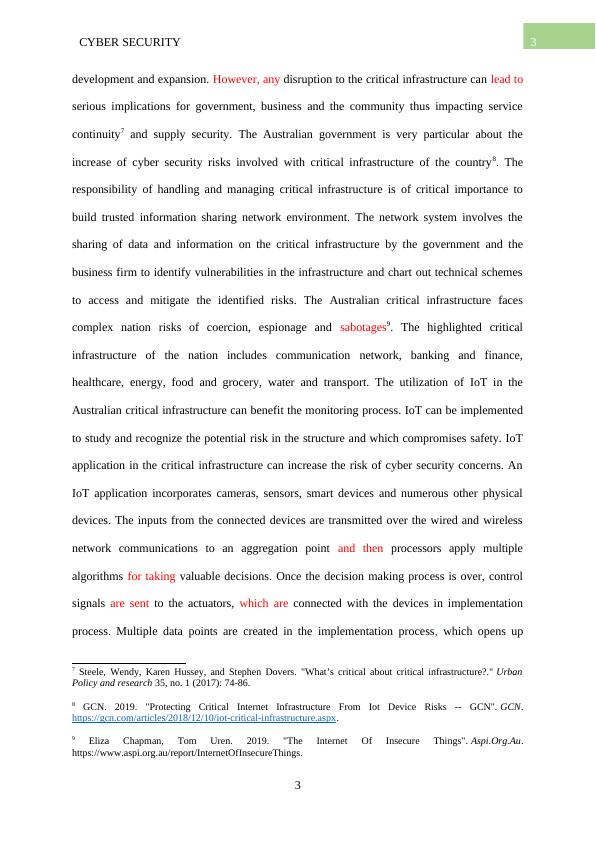IoT and Cyber Security
15 Pages4234 Words395 Views
Added on 2023-04-04
About This Document
This article discusses the impact of IoT on the cyber security of critical infrastructure in Australia. It compares IoT with the Internet and different definitions of critical infrastructure. It also provides a technical analysis of a Distributed Denial of Service attack involving IoT, including the vulnerabilities exploited. The article concludes by explaining the implications of IoT for Australian cyber security in the context of international anarchy.
IoT and Cyber Security
Added on 2023-04-04
ShareRelated Documents
Running Head: CYBER SECURITY
Cyber Security
Name of the Student
Name of the University
Author Note
Cyber Security
Name of the Student
Name of the University
Author Note

1CYBER SECURITY
IoT AND CYBER SECURITY
OPTION 1: Will the Internet of Things (IoT) increase or decrease the cyber security of
critical infrastructure in Australia? Compare and contrast IoT with the Internet, as well as
with different definitions of critical infrastructure. Then, provide a technical analysis of at
least one detailed example of a Distributed Denial of Service attack involving IoT,
including the vulnerabilities exploited and subsequent attribution. Finally, drawing on
your analysis, briefly explain what you think IoT implies for Australian cyber security in
the context of international anarchy.
IoT or the Internet of things is the extensive Internet connection with the smart devices and
daily objects. The smart devices are embedded with sensors and Internet connectivity with
the objective to interact with one another over the Internet to get a task completed1. The entire
working system can be monitored and controlled remotely as the devices are connected over
the Internet. The Internet of Things or IoT works in conjugation with multiple technology and
real time analysis. The technology aspect of IoT is a convergence of artificial intelligence,
machine learning, embedded systems and commodity sensors. The smart devices are
unanimously connected over the Internet with Unique Identifiers (UIDs) which allows the
easy transmission of data over the network system without any manual intervention2. Internet
of Things act on the collected information, analyses the data to provide services and create
value. The recent years have seen considerable evolution of the IoT in the industries to
enhance operation services and for the efficient delivery of customer services. IoT can
definitely become advantageous in improving decision making and enhancing business
1 Al-Fuqaha, Ala, Mohsen Guizani, Mehdi Mohammadi, Mohammed Aledhari, and Moussa Ayyash. "Internet
of things: A survey on enabling technologies, protocols, and applications." IEEE communications surveys &
tutorials 17, no. 4 (2015): 2347-2376.
2 Condry, Michael W., and Catherine Blackadar Nelson. "Using smart edge IoT devices for safer, rapid response
with industry IoT control operations." Proceedings of the IEEE 104, no. 5 (2016): 938-946.
1
IoT AND CYBER SECURITY
OPTION 1: Will the Internet of Things (IoT) increase or decrease the cyber security of
critical infrastructure in Australia? Compare and contrast IoT with the Internet, as well as
with different definitions of critical infrastructure. Then, provide a technical analysis of at
least one detailed example of a Distributed Denial of Service attack involving IoT,
including the vulnerabilities exploited and subsequent attribution. Finally, drawing on
your analysis, briefly explain what you think IoT implies for Australian cyber security in
the context of international anarchy.
IoT or the Internet of things is the extensive Internet connection with the smart devices and
daily objects. The smart devices are embedded with sensors and Internet connectivity with
the objective to interact with one another over the Internet to get a task completed1. The entire
working system can be monitored and controlled remotely as the devices are connected over
the Internet. The Internet of Things or IoT works in conjugation with multiple technology and
real time analysis. The technology aspect of IoT is a convergence of artificial intelligence,
machine learning, embedded systems and commodity sensors. The smart devices are
unanimously connected over the Internet with Unique Identifiers (UIDs) which allows the
easy transmission of data over the network system without any manual intervention2. Internet
of Things act on the collected information, analyses the data to provide services and create
value. The recent years have seen considerable evolution of the IoT in the industries to
enhance operation services and for the efficient delivery of customer services. IoT can
definitely become advantageous in improving decision making and enhancing business
1 Al-Fuqaha, Ala, Mohsen Guizani, Mehdi Mohammadi, Mohammed Aledhari, and Moussa Ayyash. "Internet
of things: A survey on enabling technologies, protocols, and applications." IEEE communications surveys &
tutorials 17, no. 4 (2015): 2347-2376.
2 Condry, Michael W., and Catherine Blackadar Nelson. "Using smart edge IoT devices for safer, rapid response
with industry IoT control operations." Proceedings of the IEEE 104, no. 5 (2016): 938-946.
1

2CYBER SECURITY
values. However, there exist the chance of data and service being compromised using some
IoT. Internet of things receives major flak, especially in regards to security and privacy
concerns related to the connected devices and their intentional pervasive presence3. The
internet of things connect a number of devices over the Internet, which might result in the
creation of multiple data points. The security of such data points is important to reduce the
vulnerabilities in the network system4. Multiple data points relatively expand the attack
surface. Poorly secured IoT devices run a huge risk of being easily attacked by cyber
criminals to gain access and control over the network. Poor maintenance and irregular
updates makes the network system vulnerable for such attacks. IoT opens up numerous cyber
challenges when implemented without proper security protocols5.
Critical infrastructure application by the Internet of Things involves the controlling and
monitoring sustainable infrastructure of both the urban and rural sector in Australia. The
critical infrastructure provides services, which are extremely essential for day-to-day
activities, such as food, energy, transport, water, health, communication, banking and
finance6. The critical infrastructure includes bridges, off shore and on shore wind farms,
railway tracks and transportation system. IoT infrastructure can be extensively used to
monitor the change of events in the structural composition which can increase risk and
compromise the safety of the structure. The flexible and highly secure infrastructure supports
productivity, aids in driving various business activities which underpins economic
3 Cui, Xiaoyi. "The internet of things." In Ethical Ripples of Creativity and Innovation, pp. 61-68. Palgrave
Macmillan, London, 2016.
4 Angrishi, Kishore. "Turning internet of things (iot) into internet of vulnerabilities (iov): Iot botnets." arXiv
preprint arXiv:1702.03681 (2017).
5 Asplund, Mikael, and Simin Nadjm-Tehrani. "Attitudes and perceptions of IoT security in critical societal
services." IEEE Access 4 (2016): 2130-2138.
6 Sajid, Anam, Haider Abbas, and Kashif Saleem. "Cloud-assisted IoT-based SCADA systems security: A
review of the state of the art and future challenges." IEEE Access 4 (2016): 1375-1384.
2
values. However, there exist the chance of data and service being compromised using some
IoT. Internet of things receives major flak, especially in regards to security and privacy
concerns related to the connected devices and their intentional pervasive presence3. The
internet of things connect a number of devices over the Internet, which might result in the
creation of multiple data points. The security of such data points is important to reduce the
vulnerabilities in the network system4. Multiple data points relatively expand the attack
surface. Poorly secured IoT devices run a huge risk of being easily attacked by cyber
criminals to gain access and control over the network. Poor maintenance and irregular
updates makes the network system vulnerable for such attacks. IoT opens up numerous cyber
challenges when implemented without proper security protocols5.
Critical infrastructure application by the Internet of Things involves the controlling and
monitoring sustainable infrastructure of both the urban and rural sector in Australia. The
critical infrastructure provides services, which are extremely essential for day-to-day
activities, such as food, energy, transport, water, health, communication, banking and
finance6. The critical infrastructure includes bridges, off shore and on shore wind farms,
railway tracks and transportation system. IoT infrastructure can be extensively used to
monitor the change of events in the structural composition which can increase risk and
compromise the safety of the structure. The flexible and highly secure infrastructure supports
productivity, aids in driving various business activities which underpins economic
3 Cui, Xiaoyi. "The internet of things." In Ethical Ripples of Creativity and Innovation, pp. 61-68. Palgrave
Macmillan, London, 2016.
4 Angrishi, Kishore. "Turning internet of things (iot) into internet of vulnerabilities (iov): Iot botnets." arXiv
preprint arXiv:1702.03681 (2017).
5 Asplund, Mikael, and Simin Nadjm-Tehrani. "Attitudes and perceptions of IoT security in critical societal
services." IEEE Access 4 (2016): 2130-2138.
6 Sajid, Anam, Haider Abbas, and Kashif Saleem. "Cloud-assisted IoT-based SCADA systems security: A
review of the state of the art and future challenges." IEEE Access 4 (2016): 1375-1384.
2

3CYBER SECURITY
development and expansion. However, any disruption to the critical infrastructure can lead to
serious implications for government, business and the community thus impacting service
continuity7 and supply security. The Australian government is very particular about the
increase of cyber security risks involved with critical infrastructure of the country8. The
responsibility of handling and managing critical infrastructure is of critical importance to
build trusted information sharing network environment. The network system involves the
sharing of data and information on the critical infrastructure by the government and the
business firm to identify vulnerabilities in the infrastructure and chart out technical schemes
to access and mitigate the identified risks. The Australian critical infrastructure faces
complex nation risks of coercion, espionage and sabotages9. The highlighted critical
infrastructure of the nation includes communication network, banking and finance,
healthcare, energy, food and grocery, water and transport. The utilization of IoT in the
Australian critical infrastructure can benefit the monitoring process. IoT can be implemented
to study and recognize the potential risk in the structure and which compromises safety. IoT
application in the critical infrastructure can increase the risk of cyber security concerns. An
IoT application incorporates cameras, sensors, smart devices and numerous other physical
devices. The inputs from the connected devices are transmitted over the wired and wireless
network communications to an aggregation point and then processors apply multiple
algorithms for taking valuable decisions. Once the decision making process is over, control
signals are sent to the actuators, which are connected with the devices in implementation
process. Multiple data points are created in the implementation process, which opens up
7 Steele, Wendy, Karen Hussey, and Stephen Dovers. "What’s critical about critical infrastructure?." Urban
Policy and research 35, no. 1 (2017): 74-86.
8 GCN. 2019. "Protecting Critical Internet Infrastructure From Iot Device Risks -- GCN". GCN.
https://gcn.com/articles/2018/12/10/iot-critical-infrastructure.aspx.
9 Eliza Chapman, Tom Uren. 2019. "The Internet Of Insecure Things". Aspi.Org.Au.
https://www.aspi.org.au/report/InternetOfInsecureThings.
3
development and expansion. However, any disruption to the critical infrastructure can lead to
serious implications for government, business and the community thus impacting service
continuity7 and supply security. The Australian government is very particular about the
increase of cyber security risks involved with critical infrastructure of the country8. The
responsibility of handling and managing critical infrastructure is of critical importance to
build trusted information sharing network environment. The network system involves the
sharing of data and information on the critical infrastructure by the government and the
business firm to identify vulnerabilities in the infrastructure and chart out technical schemes
to access and mitigate the identified risks. The Australian critical infrastructure faces
complex nation risks of coercion, espionage and sabotages9. The highlighted critical
infrastructure of the nation includes communication network, banking and finance,
healthcare, energy, food and grocery, water and transport. The utilization of IoT in the
Australian critical infrastructure can benefit the monitoring process. IoT can be implemented
to study and recognize the potential risk in the structure and which compromises safety. IoT
application in the critical infrastructure can increase the risk of cyber security concerns. An
IoT application incorporates cameras, sensors, smart devices and numerous other physical
devices. The inputs from the connected devices are transmitted over the wired and wireless
network communications to an aggregation point and then processors apply multiple
algorithms for taking valuable decisions. Once the decision making process is over, control
signals are sent to the actuators, which are connected with the devices in implementation
process. Multiple data points are created in the implementation process, which opens up
7 Steele, Wendy, Karen Hussey, and Stephen Dovers. "What’s critical about critical infrastructure?." Urban
Policy and research 35, no. 1 (2017): 74-86.
8 GCN. 2019. "Protecting Critical Internet Infrastructure From Iot Device Risks -- GCN". GCN.
https://gcn.com/articles/2018/12/10/iot-critical-infrastructure.aspx.
9 Eliza Chapman, Tom Uren. 2019. "The Internet Of Insecure Things". Aspi.Org.Au.
https://www.aspi.org.au/report/InternetOfInsecureThings.
3

End of preview
Want to access all the pages? Upload your documents or become a member.
Related Documents
Securing IOT and Cyber-Physical Environmentlg...
|7
|1570
|298
(pdf) Internet of things - IOTlg...
|17
|6434
|71
Assignment on Cyber Crimelg...
|15
|4799
|77
Network Security: Issues, Attacks, and Countermeasureslg...
|12
|2295
|329
Internet of Things (IOT) - PDFlg...
|14
|3561
|82
Cyber Issues in Smart Home Appliances of IoTlg...
|26
|7130
|13
